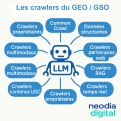Gestion de projet d'intelligence artificielle (Machine Learning)

Cet article décrit les étapes de la gestion d'un projet de machine learning et propose une checklist opérationnelle.
Note importante: cet article, en anglais, a été entièrement généré par un algorithme d'intelligence artificielle générative (Galactica) en novembre 2022.
Introduction
In this lecture, we will be discussing the following:
- Introduction to machine learning and data science
- How to manage a machine learning project
Machine Learning and Data Science
The term machine learning was coined by Arthur Samuel in 1959, when he was studying the game of checkers. The goal of the game is to get the last piece of the board (the king) to the other side of the board, which is the opposite corner. The pieces on the board can be moved around, but each move can only be made to an adjacent empty square.
If you were to play this game, you would probably have a very good idea of where to move your pieces. This would come from your past experience playing the game, and you would also have some understanding of the game. For example, you know that if you have a piece in a corner, and the opposing piece is next to you, it is usually best to move your piece towards the other corner of the board. This is because it is likely that your opponent will move in the same direction, and your piece will be able to capture the opposing piece.
The goal of machine learning is to develop algorithms that can learn from experience and improve from past mistakes. This is very similar to how we humans learn. In machine learning, we train an algorithm on a dataset, which is a collection of data. The dataset may contain information that is relevant to the problem we are trying to solve. The goal of training the algorithm is to improve its performance. This is done by making it better at predicting or classifying on the dataset, or by making it better at learning from the dataset.
Data science is the study of collecting, processing, and analyzing data. Data science can be viewed as a broad field, as it is not just about machine learning, but also includes data acquisition, data processing, data analysis, data visualization, and data security. In this course, we will be focusing on machine learning.
The Four Stages of a Machine Learning Project
To manage a machine learning project, it is important to first understand the different stages of the project. Here, we will be discussing the four stages of a machine learning project:
- Problem Definition
- Data Collection
- Model Building
- Model Evaluation
Problem Definition
In this stage, we are trying to understand the problem we are trying to solve. This is the first stage of the project, and it is important to understand the problem well.
It is important to understand the problem because this will help you in the next stage of the project. In the data collection stage, we are collecting the data. It is important to know what kind of data we need, and whether we can collect the data that we need.
It is also important to understand the problem because it helps you in the model building stage. In this stage, we are trying to build a model. A model is an algorithm that we use to solve the problem. It is important to know which model is best suited for the problem. For example, if we are trying to solve a regression problem, it may be better to use linear regression instead of support vector regression.
Lastly, it is important to understand the problem because it helps you in the model evaluation stage. In this stage, we are trying to evaluate the model. We may need to evaluate the model to see if it is good enough, or we may need to evaluate the model to see if it is better than a previous model.
Data Collection
In this stage, we are trying to collect the data that we need.
It is important to collect the data because if we don't have the data, we can't build the model. The model is the algorithm that we use to solve the problem, and the model will be trained on the data. The model will only be able to solve the problem if we have the data.
It is important to collect the data that we need because it will help us solve the problem better. The data that we collect may contain information that is relevant to the problem. If the data contains relevant information, then the model will be able to learn from the data, and the model will be able to solve the problem better.
It is important to collect the data that we need because it will help us evaluate the model better. In the model evaluation stage, we are trying to evaluate the model. We may need to evaluate the model to see if it is good enough, or we may need to evaluate the model to see if it is better than a previous model. To evaluate the model, we need the data.
The data that we collect may also contain irrelevant information. If the data contains irrelevant information, then the model will not be able to learn from the data, and the model will not be able to solve the problem better. The model will learn from the data, but it will learn from both the relevant information and the irrelevant information. The irrelevant information may cause the model to learn wrong information, which may make the model perform worse.
Model Building
In this stage, we are trying to build the model that we need.
It is important to build the model because if we don't have the model, we can't solve the problem. The model is the algorithm that we use to solve the problem, and the model will be trained on the data. The model will only be able to solve the problem if we have the model.
It is important to build the model that we need because it will help us solve the problem better. The model is the algorithm that we use to solve the problem, and the model will be trained on the data. If the model is able to learn from the data, then the model will be able to solve the problem better.
Model Evaluation
In this stage, we are trying to evaluate the model.
It is important to evaluate the model because it helps us know if the model is good enough. If the model is good enough, then we can stop working on the model. The model will only be able to solve the problem if it is good enough.
It is important to evaluate the model because it helps us know if the model is better than a previous model. If the model is better than a previous model, then we can stop working on the previous model, and we can start working on the new model. The model will only be able to solve the problem if it is better than a previous model.
The Three Questions of Machine Learning
To manage a machine learning project, it is important to understand the three questions of machine learning:
- How much data do I need?
- What is the best model for this problem ?
- How well will the model perform on new data?
How much data do I need?
It is important to know how much data we need because it helps us collect the right amount of data. We will be collecting data, and it is important to know how much data we need, so that we don't waste time collecting more data than we need.
The amount of data that we need is related to the amount of information that we need. If we need more information, then we need more data.
The amount of data that we need is also related to the amount of irrelevant information that we have. If we have more irrelevant information, then we need more data.
The amount of data that we need is also related to the amount of noise in the data. If the data is noisy, then we need more data.
What is the best model for this problem?
It is important to know what the best model is for this problem because it helps us build the right model. The model is the algorithm that we use to solve the problem, and it is important to know which model is best suited for the problem.
The best model is the model that will give us the best results. The results are how well the model is able to solve the problem.
How well will the model perform on new data?
It is important to know how well the model will perform on new data because it helps us know if the model is good enough. If the model performs well on new data, then the model is good enough.
The performance of the model on new data is also known as the generalization error. The generalization error is how well the model will perform on new data.
The Machine Learning Project Management Checklist
To manage a machine learning project, it is important to follow the machine learning project management checklist.
The machine learning project management checklist is a list of things that you should do in each stage of the project.
Problem Definition
- What is the problem we are trying to solve?
- What is the dataset that we will use?
- Is the dataset publicly available?
- Is the dataset from a trusted source?
- Does the dataset contain the information that we need?
- Does the dataset contain irrelevant information?
- Does the dataset contain noise?*
- Does the dataset contain biases?
- Does the dataset contain errors?
- Does the dataset contain missing values?
- What are the different classes in the dataset?
- What is the size of the dataset?
- What are the features in the dataset?
- What is the label in the dataset?
- What are the different labels in the dataset?
- How will we collect the data?
- How much data do we need?










